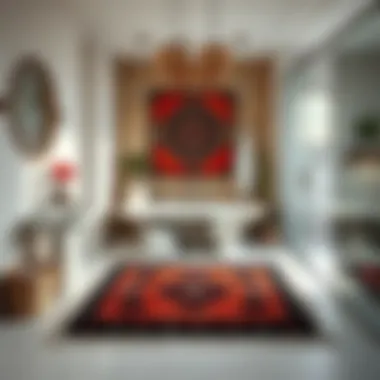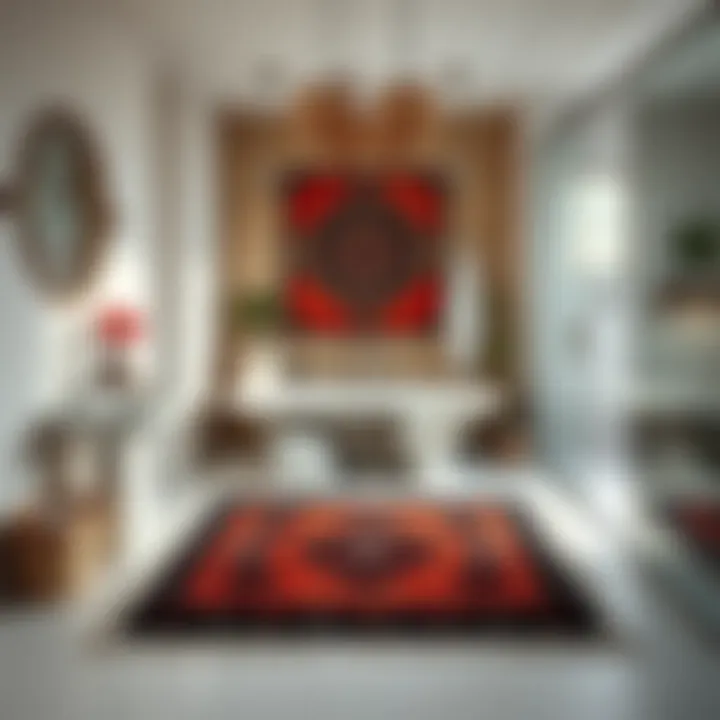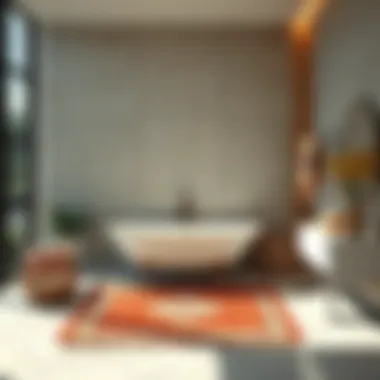The Craft and Purpose of Tribal Bath Rugs


Intro
Tribal bath rugs are not merely decorative pieces; they embody a rich tapestry of culture and tradition, bringing a touch of artistry into contemporary homes. With roots embedded in the craftsmanship of indigenous peoples from diverse regions, these rugs tell stories that resonate beyond their vivid patterns and textures. In modern bathrooms, they serve dual purposes: enhancing aesthetic appeal and promoting comfort underfoot.
In a world where personalization in home decor is increasingly valued, understanding the functionality and artistry behind tribal bath rugs is essential. Delving into their unique characteristics sheds light on how these distinct textiles can resonate with our spaces while reflecting individual style choices. Both visually striking and practically beneficial, tribal rugs are colors that can shift the mood of a room – from serene to invigorating – based on their design.
As we explore the latest trends, color palettes, and styles, we'll uncover practical advice on selecting and caring for these rugs. Ultimately, this article will empower homeowners and housewives alike to create bathrooms that not only look stunning but also feel like sanctuary.
Current Trends
In recent years, the world of interior design has seen an evident resurgence of interest in tribal motifs. This trend reflects a growing appreciation for handcrafted items that carry a legacy. Homeowners are beginning to favor rugs that blend traditional artistry with modern flair, creating captivating environments.
Color Palettes
Tribal bath rugs come in a myriad of colors that can breathe life into dull spaces. Natural earth tones, vibrant hues, and intricate patterns characterize many rugs seen today. Here are some popular color schemes:
- Earthy tones: Burnt sienna, deep greens, and sandy beiges
- Bold contrasts: Bright reds paired with soft blues or dusky yellows
- Pastel touches: Soft pinks and muted greens for a gentle vibe
Selecting the right color palette is vital. It can complement existing bathroom decor or serve as a focal point that draws attention.
Popular Styles
In terms of styles, tribal bath rugs do not disappoint. They can evoke a sense of place, whether inspired by African tribal design, Native American patterns, or even Asia's weaves. The following styles are rapidly gaining popularity:
- Berber-style rugs: Known for their plush texture and natural white or cream base, often accented with geometric designs.
- Soumak weaves: These rugs feature intricate patterns and are typically made from wool, enhancing their durability.
- Kilims: Flat-woven and lightweight, kilims display lively colors and intricate designs, perfect for adding character without overwhelming a space.
With such a diverse range of options available, integrating tribal bath rugs into bathroom decor can create a sanctuary feel that resonates with both comfort and style. Optimal placement can transform a space, enhancing both form and function.
"Choosing the right rug can make a small bathroom feel spacious or an expansive one feel cozy."
As we continue to venture into the world of tribal bath rugs, stay tuned to discover visual ideas that illustrate how to maximize these stunning pieces in your home.
Prologue to Tribal Bath Rugs
In recent years, the fascination with tribal bath rugs has surged, becoming a staple in many households. These rugs are not just decorative items; they represent a rich tapestry of history, culture, and artistry that resonates with many homeowners. Understanding their importance provides a gateway to appreciating not only their aesthetic appeal but also their functionality in modern spaces.
Tribal bath rugs are characterized by unique patterns, vibrant colors, and diverse textures that often tell a story rooted in their origins. They embody the craftsmanship of various cultures, each bringing its own flair and narrative into your bathroom. This makes them quite versatile in terms of style—whether one leans towards a bohemian vibe or a more classic décor, there's likely a tribal rug that fits the bill.
Beyond aesthetics, the functionality of these rugs can’t be overstated. They provide comfort underfoot, absorb excess moisture, and can contribute to a safe environment by preventing slips and falls in wet areas. These practical benefits make them an essential addition to any bathroom, especially in families where safety is paramount.
Nevertheless, selecting a tribal bath rug involves considerations that go beyond just appearance or functionality. It’s about finding a piece that resonates with your personal style, compliments your home’s decor, and withstands the rigors of daily use. This section dives into the significance of tribal bath rugs, setting the stage for a deeper discussion on their history, diversity, and modern relevance.
"When you introduce a tribal rug to your bathroom, you're not just adding decoration. You're inviting culture, history, and a sense of global awareness into your home."
As we explore the many facets of tribal bath rugs, we will delve into their historical context, materials, and how they can transform personal spaces into relaxing havens. This journey celebrates the artistry behind these textiles while providing practical insights for choosing the right one for your needs.
Historical Context of Tribal Textiles
Understanding the historical context of tribal textiles is vital as it sheds light on the origins and evolution of these distinct art forms, particularly tribal bath rugs. These pieces are more than decorative elements; they encapsulate stories and traditions passed through generations. The textiles carry a sense of identity, portraying the diverse cultural narratives of the tribes that created them. As such, they serve not only functional purposes within the household but also act as a bridge connecting contemporary society to ancient arts.
Tribal bath rugs are deeply rooted in the history of nomadic and settled cultures. The patterns, colors, and materials used in these rugs often reflect the geographical origins and natural resources of the region. For instance, rugs crafted in North Africa may prominently feature geometric designs inspired by the arid landscapes, while Middle Eastern pieces may exhibit intricate floral motifs signifying the region’s diverse flora. This geographical significance adds layers to their aesthetic, making each rug a narrative tapestry telling the story of its lineage.
Identifying the elements influencing tribal rug design provides insights into their cultural significance. Rug patterns can also symbolize rituals, social status, or spiritual beliefs, making them important cultural artifacts. Learning about these aspects allows homeowners to appreciate the rugs not simply as decor but as culturally rich items that enhance the ambiance of their homes.
Origins of Tribal Designs
The origins of tribal designs are often intertwined with the everyday lives of the people who made them. For many tribes, weaving was a communal activity, merging practicality with artistry. The earliest tribal designs emerged out of necessity; they filled a need for warmth and comfort on cold floors. Over time, this utility gave way to decorative elements as artisans began to incorporate symbols and motifs that held meaning within their cultures.
When studying these origins, one can see how regional resources influenced design. Take, for example, the vibrant patterns found in Peruvian textiles. The rich colors come from natural dyes made from local plants and insects, a practice passed down through generations. These colors and designs are not just aesthetically pleasing but represent a deep connection to the land.
Cultural Symbolism in Rug Patterns


Cultural symbolism plays a key role in the patterns found on tribal bath rugs. Each shape and hue may have significance. For example, in some Indigenous cultures, certain motifs can represent elements like water, sun, or earth, offering a spiritual connection to nature. The presence of these symbols can imbue a space with a sense of peace and grounding, making the bathroom—a personal and often serene space—all the more inviting.
The appreciation of cultural symbolism doesn't merely enhance the aesthetic value of the rug; it also provides insights into the traditions and beliefs of the people behind the artistry. Homeowners who understand these meanings can foster a more intentional atmosphere in their spaces. By carefully selecting rugs that resonate with them personally, they can create a home environment that reflects their values and lifestyle.
"Each tribal rug is a visual story, woven with the hands and hearts of generations. Embracing their history can transform one’s living space into a canvas of culture and identity."
Diversity of Tribal Bath Rugs
The world of tribal bath rugs is an intricate tapestry woven with culture, tradition, and functionality. Each rug tells a story that reflects its origins, and their diversity showcases not just aesthetic variations but also the nuances of craftsmanship. Understanding this diversity helps to appreciate how these rugs enrich spaces and embody values from their cultures of origin.
When one considers adding a tribal bath rug to their home, it is crucial to recognize the distinct elements that set them apart. These rugs are not merely decorative; they embody the spirit of the regions they hail from, serving practical purposes while enhancing the aesthetic of a bathroom. Choosing a tribal rug involves understanding how its design, material, and heritage harmoniously blend to create a unique statement in modern decor.
Regional Variations in Design
North African Influences
North African tribal rugs often come alive with vibrant colors and bold geometric patterns inspired by the landscapes and lifestyles of the Berber tribes. A defining aspect of these designs is the use of intricate motifs that sometimes tell stories or depict elements from daily life.
One key characteristic of North African rugs is their ability to evoke a sense of warmth and comfort. They are well-known for their thick pile, making them a beneficial choice for any bathroom due to their plush feel underfoot. The aesthetic is not only visually striking, but it also provides practical warmth, making stepping out of a shower a much more pleasant experience during cooler months.
However, the unique weaving techniques can sometimes make them a bit heavy, which might pose challenges during cleaning or repositioning. Yet, their durability and ability to withstand everyday wear balance out these disadvantages perfectly.
Middle Eastern Aesthetics
Middle Eastern tribal rugs often draw inspiration from rich cultural tapestries, featuring intricate designs that capture the elegance of Persian artistry. The key characteristic that sets them apart is the delicate knotting techniques, resulting in fine details that are not just beautiful but incredibly artistic.
These rugs can elevate the visual appeal of a bathroom, introducing complexity into spaces that can often feel plain.
One unique feature of Middle Eastern rugs is their silky sheen, often attributed to the high-quality materials used, such as wool or silk blends. They can transform an ordinary bathroom into a serene oasis, creating a calming atmosphere.
Yet, they can be on the pricier side compared to their counterparts, which may limit some homeowners' options, but the investment can pay off in the long run with unmatched beauty and longevity.
Southern Asian Techniques
Southern Asian tribal rugs are a celebration of colors and textures, often combining traditional weaving methods with contemporary design. A notable aspect of these rugs is their use of natural dyes harvested from plants and minerals, showcasing a deep respect for nature. The characteristic lively colors and eclectic patterns of Southern Asian rugs make them a strong choice for those looking to make a statement. A unique feature is the ability to blend seamlessly with both traditional and modern bathroom decor, offering versatility that few other styles can compete with. However, while these rugs are visually captivating, they may require more frequent care to maintain their vibrant colors. This can be a downside for busy households, but the joy and flair they bring to a space often outweigh the upkeep efforts.
Materials Used in Crafting Tribal Rugs
Wool and its Properties
Wool is often the backbone of tribal bath rugs, prized for its resilience and natural insulation properties. The unique aspect of wool is its ability to wick moisture away while providing comfort underfoot, an essential feature for bath rugs. A key characteristic of wool is its natural stain resistance, making it a great choice for bathrooms where spills might occur. Furthermore, wool is environmentally friendly as it is a renewable resource, appealing to those mindful of their ecological footprint. However, wool rugs can be more challenging to clean, particularly stain removal, which is something to consider when choosing a rug that will see considerable foot traffic.
Cotton Versus Synthetic Fibers
Cotton rugs are often celebrated for their softness and ease of maintenance. When comparing cotton to synthetic fibers, the natural feel of cotton can make it a more appealing option for home settings, especially in humid environments where you want a breathable material. One notable characteristic of cotton rugs is their accessibility and often lower price point. They are easy to wash, whether by hand or machine, making them practical for bathrooms. However, they may not have the same durability as wool or synthetic options, which can wear down faster under heavy use.
Synthetic fibers, on the other hand, can offer a wide array of patterns and bold colors at a reasonable price. They are typically more resistant to stains and easier to clean than cotton or wool, which makes them attractive for families. However, synthetic materials can lack the natural feel and breathability of other fibers, which may detract from the overall ambiance of the bathroom. So, making the right choice depends on balancing aesthetics, practicality, and personal preferences.
Natural Dye Techniques
The beauty of tribal rugs often lies in the hues achieved through natural dye techniques. This old-world method emphasizes using plant-based or mineral-based dyes, lending a unique quality to each rug. The irreplaceable aspect is that no two rugs will ever look exactly alike, which brings a special charm. These dyes are renowned for their depth and richness, creating colors that are more than just hues but reflections of the earth's palette. A unique characteristic of natural dyes is their ability to withstand time better than many synthetic dyes, ensuring that the colors remain vibrant for years, preserving the rug's beauty. However, the process can be labor-intensive and requires a great deal of skill, making such rugs sometimes more expensive. Yet, for those who value craftsmanship and individuality, the investment is often justified in the beauty and story a natural dye rug can bring.
The Role of Tribal Bath Rugs in Modern Decor
Tribal bath rugs hold a distinct place in the landscape of modern decor. They blend cultural heritage with contemporary aesthetics, making them a remarkable addition to any bathroom. Beyond their visual appeal, these rugs provide a fusion of functionality and artistry that resonates with homeowners and interior designers alike. Their styles can vary tremendously, yet they all possess an inherent ability to elevate the space they occupy.
Creating a Cohesive Space
Color Coordination
Color coordination acts as the backbone of interior design, especially when incorporating tribal bath rugs. It’s not merely about choosing colors that match, but about finding shades that complement each other in a harmonious balance. When a homeowner selects a tribal rug, understanding how it interacts with existing colors in the bathroom can create an inviting atmosphere.
For instance, a vibrant Moroccan-inspired rug brimming with deep reds and rich blues can act as a focal point, lending an eclectic flair to a neutral bathroom. The vivid hues can uplift the space, providing visual interest while tying together other design elements. On the flip side, choosing a rug too bold in contrast with the overall color scheme might distract rather than enhance. Striking a balance is crucial—for tribal rugs, as vibrant and diverse as they are, finding the right harmony is often what makes or breaks a design.
Complementing Existing Styles
To fit seamlessly into a bathroom's design, tribal bath rugs can effortlessly complement existing styles, ensuring that they don't clash with the overall aesthetic. For instance, if a bathroom leans towards minimalist design, a simple tribal rug with geometric patterns can introduce texture without overwhelming the space. The unique feature lies in how these rugs hold the potential to bolster and support the overarching theme of the decor.
This compatibility with existing styles allows for flexibility in choice, whether you're leaning toward bohemian, modern, or even traditional settings. However, it requires a sharp eye—while the right choice can enhance the beauty of a room, an ill-suited design can stand out like a sore thumb. Without a doubt, a thoughtful selection of tribal rugs can elevate an ordinary space to one that feels crafted and intentional.
Functional Benefits of Using Bath Rugs
Safety and Comfort
One cannot overlook the practical benefits of tribal bath rugs, particularly in terms of safety and comfort. These rugs provide a cushioned barrier against cold tiles, making stepping out of the shower or bath a notably more comfortable experience. In homes with children or elderly individuals, this aspect becomes increasingly vital. Slip prevention is another key characteristic—many tribal rugs are crafted with non-slip backs, helping to keep them securely in place. Furthermore, the soft texture of these rugs underfoot can create a warm, inviting environment. With just the right rug, one can effortlessly enhance the comfort level of a bathroom, making it a sanctuary rather than just a functional space.


Heat Retention and Maintenance of Warmth
In colder climates, the functionality of tribal bath rugs further extends to heat retention. These rugs can help maintain warmth in the bathroom, reducing the chill that often accompanies tiled or stone flooring. The natural materials used in many tribal rugs, like wool, are inherently good insulators, providing a cozy surface to step on. By effectively insulating the floor, they can help achieve a more controlled temperature— particularly beneficial during the frosty months. However, there is a consideration: rugs do require a certain level of maintenance to preserve their integrity and durability over time. Regular cleaning and care are essential, ensuring that the beauty and function do not falter amidst usage.
Tribal bath rugs are not simply decorative; they serve as a blend of art, comfort, and functional design, overwhelming any ordinary space with warmth and character.
In summary, tribal bath rugs offer an insightful blend of design and utility, making them integral to the modern bathroom aesthetic. Whether through color coordination, complementing existing styles, ensuring comfort, or providing warmth, these textiles navigate the intersection of tradition and functionality, all while enhancing the sanctity of personal spaces.
Selecting the Right Tribal Bath Rug
Choosing the perfect tribal bath rug goes beyond mere aesthetics. It’s about curating a space that resonates with your personal style while also meeting practical needs. The right rug can add warmth, comfort, and a touch of character to your bathroom, often serving as the unsung hero of interior decoration. Let’s dive into some key elements to consider when selecting a tribal bath rug for your home.
Size Considerations
When it comes to sizing, the first step is measuring the available space in your bathroom. A rug that's too small can feel lost in the room, while one that's excessively large may overwhelm the area or hinder movement. Moreover, think about the layout of your bathroom. If you have a double vanity, two smaller rugs may work better than one large one.
In terms of shape, rectangular rugs are common, but don’t overlook circular or even unique asymmetrical designs that could add flair. Balancing the scale of furnishings—like a bulky cabinet or a sleek pedestal sink—will bring harmony to your surroundings. Ultimately, the size you choose should enhance the functionality, creating a cozy spot for your feet while maintaining a clear path in a wet environment.
Choosing Colors and Patterns
The colors and patterns of a tribal bath rug can dramatically influence the ambiance of your bathroom. Take a moment to reflect on the existing color palette in the space. If your tiles or walls are in neutral tones, a vibrant rug can deliver a lovely pop of color, while a more subdued design can soften bold hues.
Patterns often tell a story, stemming from rich cultural backgrounds. Opt for intricate geometrical designs or more organic motifs based on the traditions of the specific tribe. Knowing the cultural significance can also enhance your connection to the piece. Whether you prefer a rug that boldly displays its tribal origins or something more subdued, make sure that it speaks to you and fits the overall aesthetic.
Assessing Quality and Craftsmanship
Quality is key when it comes to tribal rugs. They often feature really finest materials, whether it be lush wool or durable cotton. Observe the weaving technique—handwoven rugs generally boast superior craftsmanship compared to mass-produced options, which often lack character and longevity.
Check for how tightly the fibers are woven; tighter weaves mean more durability and better resistance to wear and tear. Take the time to feel the texture too. A high-quality rug should feel soft yet robust underfoot, giving you that sought-after comfort every time you step out of the shower.
When evaluating craftsmanship, don’t hesitate to ask questions. An artisan’s story about the rug’s creation adds a personal touch and deepens the appreciation for the piece. Confirmation of ethical sourcing and proper support of indigenous artisans is also an essential factor that enriches the rug's inherent value.
Understanding the importance of size, color, pattern, and craftsmanship can lead you to not just a beautiful piece, but one that will withstand the test of time in your home.
Incorporating the right tribal bath rug can transform your bathroom from mundane to magnificent. With careful consideration of size, color, and quality, you’ll find a rug that not only fits seamlessly into your space but also enhances your daily life.
Caring for Tribal Bath Rugs
Caring for tribal bath rugs is crucial in preserving their beauty and functionality. These unique textiles not only serve a decorative purpose but also contribute significantly to the comfort of your bathroom. Proper care ensures that the vibrancy of the patterns and colors remains intact while also extending the life of the rug itself.
Cleaning Techniques
Hand Washing vs. Machine Washing
When it comes to cleaning tribal bath rugs, the method of washing can make a world of difference. Hand washing, for instance, is often deemed the gentler approach. It allows for more control and helps prevent the wear and tear that machine washing may cause. By using cool water and a mild detergent, you can delicately work out stains without risking the integrity of the fibers.
On the flip side, machine washing is convenient for those on a tighter schedule. It offers a quicker way to clean the rugs, but it is essential to use a gentle cycle and avoid overloading the machine. Ultimately, the choice between hand washing and machine washing hinges on the rug’s material and construction. Consider the label instructions; they often provide guidelines that can help you make the right decision.
- Advantages of hand washing:
- Disadvantages of hand washing:
- Advantages of machine washing:
- Disadvantages of machine washing:
- Greater control over cleaning process
- Lower risk of damage to fibers
- More time-consuming than machine washing
- Efficient for busy households
- Quick cleaning method
- Possible damage if not done carefully
Using Eco-Friendly Detergents
Using eco-friendly detergents elevates your rug cleaning game beyond mere aesthetics. These products not only clean effectively but also protect the environment. Many standard detergents contain harsh chemicals that can fade the colors and degrade the fibers of tribal rugs over time. In contrast, eco-friendly deteregnts are designed using natural ingredients that are gentler yet effective.
When selecting a detergent, opting for plant-based options often rewards you with a safe and vibrant cleaning experience. It becomes a win-win situation as you nurture both your rug and the Earth.


- Key characteristics of eco-friendly detergents:
- Advantages:
- Derived from natural ingredients
- Less harmful to the environment
- Extended vibrancy of colors
- Reduced risk of chemical damage to fibers
Storing and Maintaining Rugs
Avoiding Sunlight Damage
One significant aspect of maintaining tribal bath rugs is protecting them from sunlight. Direct exposure to sunlight can lead to fading, potentially ruining the intricate designs crafted into the rugs. This preservation technique is particularly beneficial if your rug is placed near windows. Keeping them in shaded areas can go a long way in prolonging their life and vibrancy.
- Why avoidance of sunlight is important:
- Prevents color fading
- Maintains overall integrity of the material
Proper Folding Methods
When it comes to storing your tribal rugs, knowing the right folding methods is essential. Improper folding can lead to creases and deformities that negatively impact the rug's appearance when it’s time to use it again. A good way to fold them is to roll instead of folding wherever possible, to distribute pressure evenly.
- Benefits of proper folding:
- Reduces the risk of creases
- Helps retain the original shape
Taking these measures not only helps in preserving the artwork but also ensures that these beautiful fabrics can continue to enliven your spaces for years to come. Every rug tells a story, and by caring for them properly, you help keep those narratives alive.
Sustainable Practices in Tribal Rug Production
Sustainable practices in tribal rug production are not just a trend but a necessity in preserving both cultural heritage and the environment. These rugs, rich in artistry and tradition, hold not only aesthetic value but also potential impacts on ecological sustainability. By focusing on ethical methods and resource management, tribal rug artisans contribute to a more sustainable world and ensure the legacy of their craftsmanship for future generations.
Adopting sustainable practices delivers multiple benefits. To begin with, it promotes biodiversity by encouraging the use of natural materials and traditional weaving techniques that minimize waste. Moreover, such practices often involve less harmful chemicals in dyeing processes, further protecting surrounding ecosystems. Households opting for tribal rugs that reflect these values engage in conscientious consumerism, reinforcing the importance of ecological balance.
Additionally, sustainable production brings about economic advantages for artisans and their communities. By supporting local economies through ethical sourcing and fair trade, consumers help to secure the livelihoods of these craftsmen while keeping cultural arts alive. In this way, choosing tribal rugs made through sustainable means acts as a powerful statement endorsing environmental responsibility and cultural preservation.
"The craftsmanship in tribal rugs is a direct thread connecting us to nature and tradition."
Ethical Sourcing of Materials
When we talk about ethical sourcing in the context of tribal rugs, we mean the careful selection of materials that considers both environmental impact and social justice. Artisans often rely on locally sourced materials, such as wool from sheep raised in the region or cotton grown in nearby fields. This local sourcing minimizes the carbon footprint tied to transportation and supports the local economy.
Moreover, the choice of dyes plays an integral role. Many tribal artisans are reviving the use of natural dyes, made from plants, minerals, and other organic substances. Unlike synthetic dyes that can leach harmful chemicals into the water supply, natural dyes are biodegradable and less harmful to humans and wildlife alike.
In summary, forward-thinking artisans are making strides by employing responsible sourcing practices that ensure not just beauty, but also respect for the earth and the communities they stem from.
Support for Indigenous Artisans
Support for indigenous artisans extends beyond mere economic assistance; it's about empowering communities and safeguarding cultural expressions. The artistry found in tribal rugs is not only a craft but a vital form of cultural storytelling that reflects the lives, struggles, and triumphs of the creators. When consumers purchase these rugs, they are not just acquiring a decorative item but are also taking part in the narrative of those who weave these intricate patterns.
Many organizations and initiatives are dedicated to promoting fair trade and sourcing practices that benefit these artisans. They provide training, resources, and access to global markets, enhancing the artisans' ability to thrive economically while preserving their unique cultural identities. Ethical marketplaces are becoming increasingly popular, allowing consumers to buy items directly from artisans.
This relationship fosters a sense of connection. When you choose a tribal bath rug, you are affirming the value of a handcrafted piece, imbued with history and love. Households that consciously support indigenous artisans contribute to a cycle of sustainability and cultural reverence, helping to keep these traditions alive in an ever-globalizing world.
Finale: The Lasting Impact of Tribal Bath Rugs
In examining the role of tribal bath rugs within the broader context of home decor, it's essential to note the profound impact they can have on both aesthetics and functionality. These rugs are not just mere accessories; they serve as vibrant expressions of cultural heritage while adding warmth and comfort to personal spaces.
Cultural Connection
Tribal bath rugs carry with them the stories and traditions of the artisans who craft them. Each rug is a tapestry of history, providing a glimpse into the lives, practices, and values of the communities from which they originate. By integrating these pieces into our homes, we foster a deeper appreciation for diversity and artisanal craftsmanship. The colors, patterns, and materials all tell a tale—often rooted in ancient practices that have been passed down through generations. This connection can elevate a bathroom, turning it into a serene space reminiscent of distant lands.
Functional Benefits
Beyond their aesthetic appeal, tribal bath rugs offer practical benefits that improve comfort in daily life. They provide a comforting cushion underfoot, especially on cold bathroom tiles. This can significantly enhance the experience of stepping out of a shower or bath, providing that much-needed comfort. Additionally, many tribal rugs are crafted from natural materials such as wool and cotton, which have moisture-wicking properties, essential for a bathroom environment. They help to absorb water, reducing the risk of slips and falls, which is crucial for family safety.
"The right rug can transform a simple space into an oasis of relaxation, where beauty meets practicality."
Creating Harmony in Your Space
Another noteworthy aspect lies in how these rugs can act as unifying elements in your decor. When chosen carefully, a tribal bath rug can tie together various design elements of the bathroom, creating a cohesive and inviting atmosphere. Consider how a bold, patterned rug can serve as a centerpiece, drawing the eye while complementing surrounding elements like wall colors and fixtures. Conversely, a neutral-toned rug might provide a subtle contrast, allowing ornate tiles or vibrant bathroom linens to shine.
Personal Sanctuary
Ultimately, tribal bath rugs can enhance the personal sanctuary we've all created within our homes. Choosing these rugs is not merely about decor; it is also about crafting a space that reflects one’s identity and values. They offer a sense of grounding amidst our busy lives, transforming a functional area into a retreat of tranquility.
As we move forward, the lasting impact of tribal bath rugs becomes increasingly clear. They remind us of the beauty of cultural diversity, the importance of quality craftsmanship, and the need for functional decor. When you step onto a tribal bath rug, you step onto a piece of history, comfort, and art. It’s a small but significant way to bring warmth and character into modern-day living.
For more insights into the cultural significance of tribal textiles, you may visit Britannica which provides a broader context on the topic.



